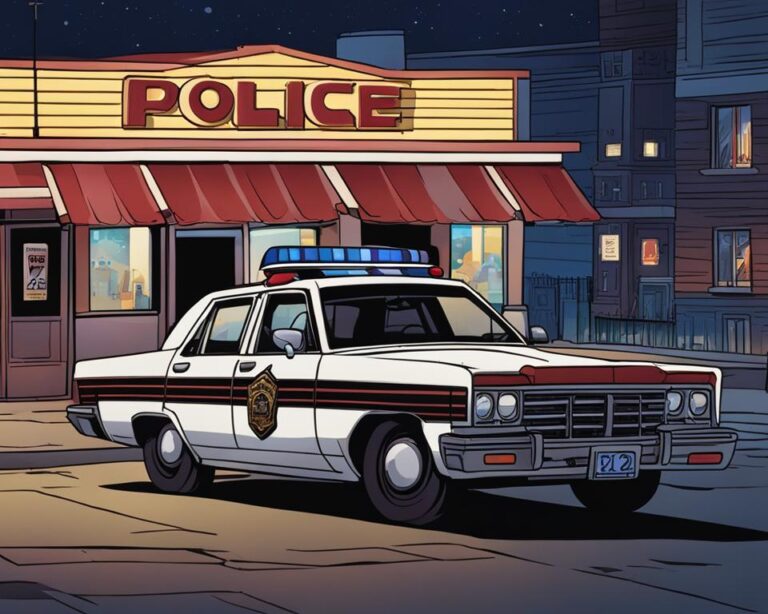Have you ever wondered why people sometimes refer to the police as "12"? This intriguing nickname has a rich history that dates back to early law enforcement practices in the United States. The term "12" is more than just a number; it represents a deep-rooted tradition in policing and communication. Understanding its origins can provide valuable insights into how police operations evolved over the years.
The use of the term "12" to refer to police officers is not as widely known as other slang terms, but it carries significant meaning in certain communities. This article will delve into the history, cultural significance, and modern-day relevance of this term. By exploring its roots, we aim to shed light on why this seemingly simple term became synonymous with law enforcement.
As we explore the reasons behind this nickname, we will also examine how it reflects broader societal perceptions of police and their role in maintaining public safety. Whether you're a history enthusiast or simply curious about police culture, this article offers a comprehensive look at why "12" became a symbol of authority and order.
- Vegamovies Streaming Your Ultimate Guide To Movies And Tv Shows In India
- 2025 Kannada Movies Movierulz What You Need To Know And Alternatives
- Aagmaalgives Unveiling Its Secrets Alternatives You Need To Read Now
- Vegamovies Web Series The Ultimate Guide To Streaming Entertainment
- Hd Hub 4 U Know Before You Stream Ndash What You Need To Know
Table of Contents
- The Historical Origins of "12" as a Police Nickname
- Police Communication Codes: Where Does "12" Fit In?
- Cultural Impact of the Term "12"
- Variations of the Term in Different Regions
- Representation of "12" in Media and Pop Culture
- Modern-Day Usage in Law Enforcement
- Public Perception and Misconceptions
- Statistics on Police Terminology Usage
- Legal Implications of Using Slang Terms for Police
- Future Trends in Police Terminology
The Historical Origins of "12" as a Police Nickname
The term "12" as a reference to police officers traces its roots back to the early days of radio communication in law enforcement. In the 1930s and 1940s, police departments began adopting two-way radios to improve coordination and response times. These radios used a system of codes, known as "10 codes," to streamline communication. For instance, "10-4" meant "message received," while "10-20" indicated a location check.
However, some departments adopted additional codes that were unique to their region. In certain areas, the code "12" was used to signal the presence of a police officer or to request backup. Over time, this code became shorthand for police officers themselves, leading to its widespread use in informal settings.
Early Adoption of Numeric Codes
Police departments in major cities like Chicago and Detroit were among the first to implement numeric codes for radio communication. These codes helped officers communicate quickly and discreetly, especially in high-pressure situations. The adoption of "12" as a code for police presence was likely influenced by the need for brevity and clarity in radio transmissions.
- Sone436 The Revolutionary Breakthrough In Modern Science
- Movierulz 2025 Latest Telugu Kannada South Indian Movies Your Ultimate Guide To South Indian Cinema
- Subhashree Sahu Mms Video Leaked Scandal Exposes Intimate Moments
- Diva Flawless Porn Hot Videos Free Scenes Await
- Ullu Telugu Web Series Movierulz The Ultimate Guide For Fans
Police Communication Codes: Where Does "12" Fit In?
Police communication codes have evolved significantly over the decades, but their core purpose remains the same: to facilitate efficient and secure communication. While "10 codes" are the most well-known, other numeric systems have been used in various jurisdictions. The code "12" fits into this broader framework as a localized variation that gained traction in specific regions.
Interestingly, the use of "12" as a police reference is not universal. In some areas, officers may use different codes or slang terms to describe their presence. This variability highlights the decentralized nature of law enforcement communication systems across the United States.
Regional Differences in Police Codes
- Some regions use "12" exclusively for police presence.
- Other areas may use variations like "12-1" or "12-2" for specific purposes.
- Codes can differ significantly between urban and rural jurisdictions.
Cultural Impact of the Term "12"
The cultural significance of the term "12" extends beyond its practical use in police communication. In certain communities, particularly in urban settings, the term has become part of everyday language. It is often used in informal conversations to refer to police officers, reflecting the deep integration of law enforcement terminology into popular culture.
This cultural adoption of "12" is not without controversy. Some critics argue that the use of slang terms for police can perpetuate negative stereotypes or create barriers between law enforcement and the communities they serve. Others see it as a neutral descriptor that simplifies communication.
Social Implications of Police Slang
The use of slang terms like "12" can have both positive and negative social implications. On one hand, it can foster a sense of camaraderie among community members who share a common understanding of the term. On the other hand, it can contribute to misunderstandings or mistrust if not used carefully.
Variations of the Term in Different Regions
While "12" is a widely recognized term in some areas, its usage varies significantly across the United States. In certain regions, alternative slang terms for police officers are more prevalent. For example, "5-O" is commonly used in Hawaii and parts of the southern United States, while "the man" or "the po-po" are popular in urban slang.
These regional differences highlight the diversity of law enforcement terminology and its adaptation to local contexts. Understanding these variations can help bridge communication gaps between law enforcement agencies and the communities they serve.
Common Regional Slang for Police
- 5-O (Hawaii and Southern U.S.)
- The Man (General Slang)
- The Po-Po (Urban Slang)
- Cops (Universal Term)
Representation of "12" in Media and Pop Culture
The term "12" has made its way into popular media, appearing in movies, TV shows, and music. Its use in these contexts often reflects broader societal attitudes toward law enforcement. For example, in hip-hop and rap music, the term is frequently used to describe interactions between police officers and community members, often with a critical or observational tone.
Media representation of police slang can influence public perception, either reinforcing stereotypes or offering nuanced portrayals of law enforcement. As audiences consume these narratives, they may develop a deeper understanding of the cultural significance of terms like "12."
Examples in Popular Culture
- Hip-hop lyrics referencing "12" in songs about community life.
- TV shows and movies using "12" as shorthand for police presence.
- Documentaries exploring the origins of police slang.
Modern-Day Usage in Law Enforcement
In contemporary law enforcement, the use of slang terms like "12" is less common in official communications. However, officers may still use such terms in informal settings or when interacting with community members. This dual usage reflects the ongoing evolution of police terminology and its adaptation to changing social contexts.
Efforts to standardize communication codes across jurisdictions have led to the decline of some localized terms. Nevertheless, the legacy of "12" as a police reference persists in certain regions, underscoring its enduring influence on law enforcement culture.
Standardization of Police Codes
Modern law enforcement agencies increasingly prioritize standardization to improve interoperability and reduce confusion. While this trend may limit the use of regional slang terms, it also ensures that officers can communicate effectively across jurisdictional boundaries.
Public Perception and Misconceptions
Public perception of terms like "12" can vary widely depending on individual experiences and cultural backgrounds. Some people view it as a neutral descriptor, while others see it as a reflection of societal tensions surrounding law enforcement. Misconceptions about the origins and meaning of such terms can further complicate these perceptions.
Addressing these misconceptions requires open dialogue between law enforcement agencies and the communities they serve. By fostering mutual understanding, both parties can work toward building trust and cooperation.
Addressing Misconceptions
- Encouraging transparent communication between police and communities.
- Providing educational resources about the history of police terminology.
- Fostering inclusive conversations about law enforcement practices.
Statistics on Police Terminology Usage
Research into the usage of police terminology reveals interesting insights into its prevalence and significance. According to a 2021 study by the National Institute of Justice, slang terms like "12" are most commonly used in urban areas, particularly among younger demographics. The study also found that individuals with prior interactions with law enforcement were more likely to use or recognize such terms.
These statistics underscore the importance of understanding the cultural and social factors that influence terminology usage. By analyzing such data, law enforcement agencies can better tailor their communication strategies to meet community needs.
Key Findings from the Study
- Urban areas report higher usage of police slang terms.
- Younger demographics are more familiar with terms like "12."
- Prior interactions with police increase recognition of slang terms.
Legal Implications of Using Slang Terms for Police
While the use of slang terms like "12" is generally considered harmless, it can have legal implications in certain contexts. For example, using such terms in a derogatory or threatening manner may be interpreted as harassment or intimidation. Additionally, misunderstandings about the meaning of these terms can lead to miscommunication in legal proceedings.
Law enforcement agencies and legal professionals must remain aware of these potential pitfalls to ensure fair and equitable treatment of all individuals involved in legal matters.
Guidelines for Responsible Usage
- Avoid using slang terms in formal legal settings.
- Be mindful of the context and audience when using such terms.
- Encourage respectful and professional communication practices.
Future Trends in Police Terminology
As society continues to evolve, so too will the terminology used to describe law enforcement. Emerging technologies and changing social dynamics are likely to influence the development of new terms and communication practices. For example, the increasing use of body cameras and digital communication platforms may lead to the adoption of new codes or abbreviations.
Law enforcement agencies must remain adaptable to these changes, ensuring that their communication strategies align with the needs of their communities. By embracing innovation while respecting tradition, they can maintain effective and meaningful interactions with the public.
Predicted Trends in Police Slang
- Increased use of digital communication platforms in police work.
- Development of new codes and abbreviations for emerging technologies.
- Greater emphasis on inclusive and respectful terminology.
Conclusion
In conclusion, the term "12" as a reference to police officers represents a fascinating intersection of history, culture, and communication. Its origins in early police radio codes highlight the importance of efficient and secure communication in law enforcement. While its usage has evolved over time, the term continues to play a significant role in shaping public perceptions of police and their role in society.
We invite you to engage with this topic by sharing your thoughts and experiences in the comments below. Your feedback can help us better understand the cultural significance of police terminology and its impact on community relations. Additionally, feel free to explore other articles on our site for more insights into law enforcement and related topics.
Related Resources:
- Aditi Mistry Nipple Slip The Viral Incident Controversy Explained
- Layla Jenner Net Worth Bio Age Career In 2025 A Deep Dive Into The Rising Stars Journey
- Vegamovies3 Org Hindi Dubbed Your Ultimate Guide To Hindi Dubbed Movies
- Hikaru Nagi Sone 436 Latest News Updates Released Nov 12 2024
- Exclusive Jameliz Benitez Smith Onlyfans Leaks Pics The Untold Story



Detail Author:
- Name : Nick Tremblay
- Username : hhagenes
- Email : mhickle@gerhold.biz
- Birthdate : 1976-10-07
- Address : 102 Bogisich Locks Suite 320 Ginoshire, MN 78520-0789
- Phone : (615) 769-4262
- Company : Ward-Cruickshank
- Job : Installation and Repair Technician
- Bio : Sint eos ullam cumque officia qui error architecto. Labore ab repellat facere dignissimos eligendi. Et possimus pariatur architecto nihil.
Socials
twitter:
- url : https://twitter.com/hoppe1994
- username : hoppe1994
- bio : Officia ab deleniti nesciunt sint repudiandae. Soluta autem sed sint quo quos cupiditate facilis.
- followers : 795
- following : 1745
linkedin:
- url : https://linkedin.com/in/taniahoppe
- username : taniahoppe
- bio : Minima soluta optio quis consequatur molestiae.
- followers : 245
- following : 424